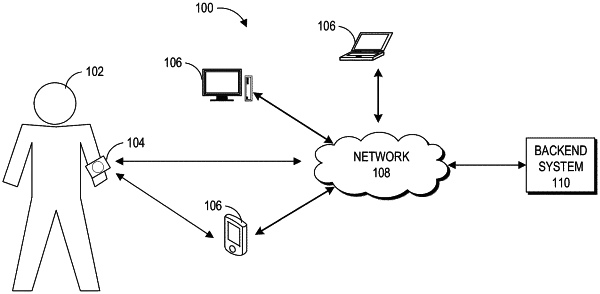| CPC G16H 40/67 (2018.01) [G06F 3/0483 (2013.01); G16H 10/60 (2018.01); G16H 80/00 (2018.01)] | 18 Claims |

|
1. A health data communication system, the system comprising:
a network interface configured to receive data from a plurality of sources, the plurality of sources comprising:
a non-transitory computer storage medium configured to at least store computer-readable instructions; and
one or more hardware processors in communication with the non-transitory computer storage medium, the one or more hardware processors configured to execute the computer-readable instructions to at least:
receive data from the plurality of sources associated with a patient, the plurality of sources having at least some disparate data storage application programming interfaces, the plurality of sources comprising:
one or more physiological data sources configured to provide physiological data from one or more sensors, and
medical record data from a plurality of disparate different electronic health record data stores having respective different data storage application programming interfaces, the medical record data comprising clinical notes;
process and aggregate the data from the plurality of sources having at least some disparate data storage application programming interfaces to fit a pre-determined format to generate processed data, such processing comprising at least data correlation of different types of data from different sources of the plurality of sources, having one or more common characteristics, the pre-determined format comprising a graph and/or a table;
save the data processed data to a database, the processed data generated from the received data from the sensor and from the one or more physiological data sources and the plurality of disparate different electronic health record data stores having respective different data storage application programming interfaces to fit the pre-determined format;
facilitate real-time communication over at least one network between a computing device of a user and a computing device of the patient,
wherein the computing device of the user comprises:
a first camera,
a first microphone,
a first sound reproduction device, and
a first display;
wherein the computing device of the patient comprises:
a second camera,
a second microphone,
a second sound reproduction device, and
a second display;
enable audiovisual information of the user to be captured using the first camera and the first microphone;
enable a real-time audio-visual telehealth call between the computing device of the patient and the computing device of user;
enable a real time display of visual information associated with the real-time audio-visual telehealth call within a graphical user interface on the first display of the computing device of the user, and enable audio information associated with the real-time audio-visual telehealth call to be reproduced using the second sound reproduction device;
receive a request to access the processed data associated with the patient from the computing device of the user, the processed data generated from the received data from the one or more physiological data sources and from the plurality of disparate different electronic health record data stores having respective different data storage application programming interfaces to fit the pre-determined format; and
cause to simultaneously display, along with the real time visual information displayed on the first display of the computing device of the user, within the graphical user interface:
a first navigable screen and that provides access to a plurality of other navigable screens on the first display of the computing device of the user, the first navigable screen and the plurality of other navigable screens configured to display:
telehealth visit content, and
respective subsets of the processed data generated from the received data from the one or more physiological data sources and from the plurality of disparate different electronic health record data stores having respective different data storage application programming interfaces to fit the pre-determined format, while continuing to output visual information on the first display of the computing device of the user,
wherein the first navigable screen, and respective other navigable screens in the plurality of screens, are respectively configured to display aspects of at least some of the plurality of sources.
|